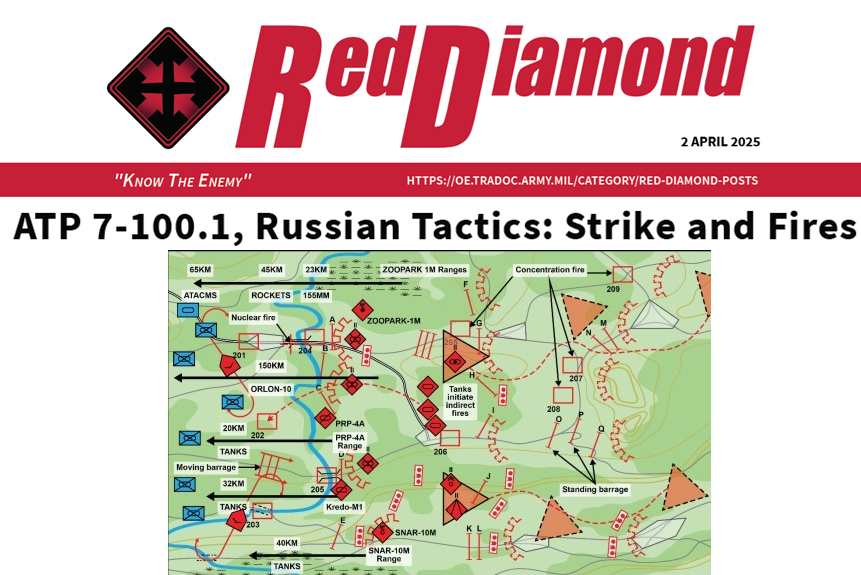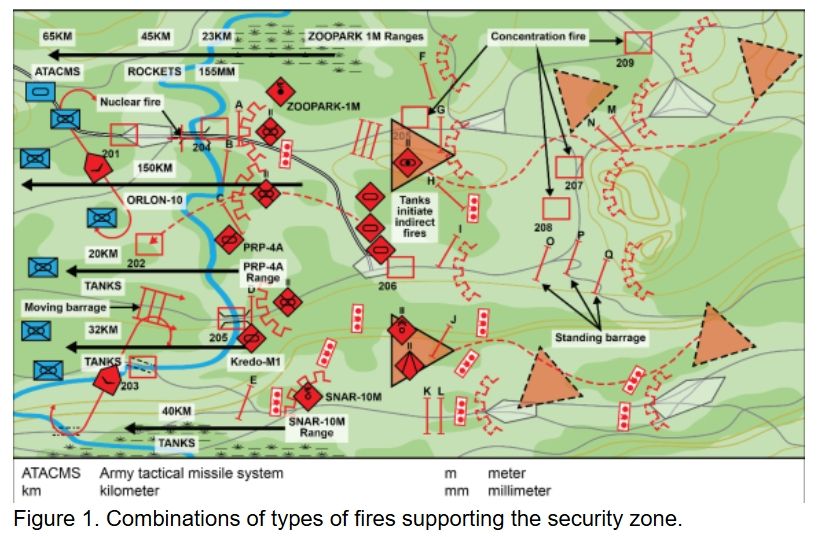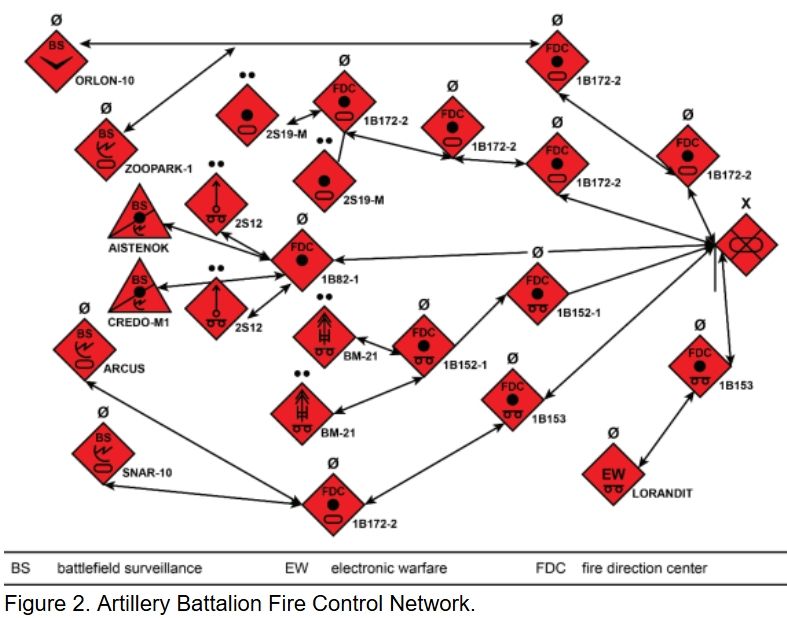
ATP 7-100.1, Russian Tactics: Strike and Fires
By TRADOC G2
This article features an excerpt from the newly released Army Techniques Publication (ATP) 7-100.1, "Russian Tactics." It seeks to simplify important concepts from the doctrinal publication into shorter, more easily understandable sections. The focus of this article will be on how Russian doctrine describes the strike and fires complex.
This article will examine how Russian doctrine describes the defense and explore the doctrinal application of the positional defense. The material is drawn from Chapter 5: Strike and Appendix A: Fires of ATP 7-100.1.i
Introduction to Russian Strike. The Russian military integrates effects from all available forces and means against an aggressor force as a strike that incorporates everything from pre-conflict information warfare to nuclear fires. Where the Soviet-era ground forces relied on massed artillery to create the desired battlefield effects, the current and future Russian Ground Forces (SV) will integrate the capabilities of more precise reconnaissance, improved fire range and rates, and automated C2 complexes and still use massed fires to achieve the desired level of damage on aggressor targets.
Russian drones routinely train with maneuver and artillery units and subunits to provide real-time target acquisition. These new capabilities continue the Russian principle that fires create the conditions that allow successful battlefield maneuver.
The SV’s use of strike seeks to integrate all effects whether they be from Information Warfare (IV), Missile and Artillery Troops (RViA), Radio-Electronic Battle (REB), Nuclear Biological and Chemical Troops (RCBZ), Aerospace Forces (VKS), or irregular warfare actions. Integration of these different capabilities at strategic and operational levels are Russia’s primary focus with tactical-level fires considered a secondary or culminating action to defeat or destroy an aggressor. At the tactical level, strike predominantly relies on fires from direct and indirect units and subunits to achieve the desired outcomes in combined-arms battle. The main focus of this chapter is the direct and indirect fires that the SV uses to achieve mission success and the other strike elements to support tactical ground actions.
The reorganized SV continues to evolve the capabilities of ground maneuver forces while integrating network-centric warfare capabilities in a shift towards information dominance on the battlefield. Improved information flow in the SV allows a greater reliance on use of more precise targeting of fires to accomplish required battlefield effects. The SV considers the effects of precise targeting and fires to equal the impact of tactical nuclear weapons. This evolution does not change the SV use of fires as the leading force and means to accomplish actions during local wars and armed conflicts, defense, and offense. As the basis for the evolving integrated fires concept, the Russian military culture continues to view artillery fires as the true “God of War” as attributed to Joseph Stalin during World War II.
Russian understanding of nonlinear warfare also guides the evolution of the SV force and their doctrine. The Russians view the characteristics of this type of warfare as follows—
- Long-range destruction by aerospace, naval, and indirect fire ground forces of aggressor targets prior to contact.
- Rapid planning and execution of combined arms actions by highly maneuverable forces and means.
- Destruction of aggressor targets primarily by artillery and other strike assets.
- VTO fire capabilities allow target destruction without contact.
- Automated target acquisition and transmission to the strike delivery systems.
As indicated by the majority of the nonlinear warfare characteristics being associated with strikes and their employment, one gains an appreciation of the priority placed on the function. Russia’s nonlinear battle concept anticipates the SV maneuver forces continuing to seize and hold terrain but only after strike complexes destroy aggressor units. The SV integrates all strike assets to focus on an aggressor force and remove its ability to affect the battle outcome. Strikes include artillery, rocket, and missile medium-to-long range massed indirect fires, engineer mines, nuclear, chemical, special operations forces, IV and REB attacks, as well as irregular forces that influence or affect the tactical battle.
The strike systems of the Russian military and the SV particularly rely on integration and layering of capabilities beginning at the strategic level down to tactical platoons. Organic system capabilities coupled with allocated weapons from higher level units and integrated with those of neighboring units serves to create a system of fire to defeat an aggressor attacking the front, flanks, or rear of the formation.
Russian military doctrine views indirect fires as a critical function for all combat operations. Destruction or suppression of aggressor forces using effective fire units and complexes are necessary to set the conditions for successful ground operations. Initially, the SV senior commander and their staff plan the application of fires from various levels using scientific substantiation that includes determining the correlation of forces and means and applying established normative quantities. Normative application defines space and timing of unit and subunit maneuvers, expenditure of forces and means, and the resulting required supply quantities. For fires, these calculations stipulate the volume and timing of fires necessary to accomplish a specified mission.
As the SV executes the commander’s plan during armed conflicts/local wars, defense, and offense the fire units conduct precise targeting for selective and massed fires as well as responding to targets of opportunity identified by reconnaissance or maneuver of SV units. For tactical-level formations this process determines the use of organic fire systems within a brigade or regiment and any allocation of strike effects from units or subunits of higher level RViA formations and supporting actions from the VKS or REB units.

At the tactical level, doctrinal application of fires continues allocation of the type and volume of fire necessary to achieve the desired effect on the aggressor target. The SV employs several types of fires to accomplish actions during armed conflicts and local wars, defense, and offense. Their VTO capabilities continue to grow while they retain the ability to launch massed artillery fire strikes to support the commander’s plan. The commander assigns artillery missions determined by the desired percentage reduction of effectiveness of a target. The mission type and size of the target area are variables used by nomograms to determine the volume of fire required from firing units to achieve the specified percent of damage.
The following are examples of artillery missions with desired percentages of reduction—
- Annihilation —Reduction in effectiveness of 70–90%. Loss of complete combat effectiveness.
- Destruction —Reduction in effectiveness of 50–60%. Unfit for combat operations.
- Neutralization/suppression —Effectiveness reduction of 30%. Severe damage but still capable of combat operation.
- Harassment —Intended impact is psychological rather than a percentage of destruction. A limited number of firing units and rounds fired on a specified schedule, to disrupt aggressor forces in static positions.
The planned fires of the artillery groupings enable maneuver by SV brigades, regiments, and battalion tactical groups (BTGs) to strike the aggressor force at the time and place specified in the commander’s decision. These strikes engage aggressor forces or positions at the critical time with the volume and type fires necessary to annihilate, destroy, or suppress those forces.
In a defense there are artillery reconnaissance vehicles positioned behind the first echelon companies or the second echelon company strongpoints. These reconnaissance vehicles provide direct observation of the front and flanks of a defending unit. This capability allows the collection, analysis, and assessment of all detected battlefield actions and the resulting rapid adaptation to changing conditions. These vehicles provide additional target acquisition capabilities and feed information to a fire direction center that provides fire solutions to the firing subunits.
During offensive actions artillery reconnaissance vehicles maneuver with the forward reconnaissance detachments to provide fire direction to supporting artillery groups as much as 20 KM forward of the marching main body. Artillery reconnaissance vehicles such as the PRP-4A Argus at the brigade and regimental level provide radar detection of moving tank type targets at up to 12 KM. The Argus also uses electro-optical sensors to identify tank targets at up to 8 KM during the day and 3 KM during nighttime. Information gathered by UAVs is passed to artillery reconnaissance by ground control of the UAS unit or subunit and the maneuver command post. In the brigade and division there are both man portable and vehicle mounted radars that add to the target acquisition capabilities. These reconnaissance platforms are linked by automated mobile field C2 systems such as the Strelets or Bylina to direct the actions of SV units.

The SV employs fires to accomplish the required level of damage or destruction specified by the commander’s plan using the following fire types. The basis for the fire type or types selected by the commander are the artillery norms. Nowhere are norms more important than in their artillery application where artillery effectiveness is the prime means of reducing aggressor battlefield effectiveness. Planned fire classifications and the combinations used to form various patterns that support combat action following the descriptions:
- Fire Blocks. A line of fire designed to prevent an aggressor or irregular unit from leaving an area.
- Fire Sweeps. A moving barrage used to drive aggressor or irregular forces in a desired direction.
- Defensive Box. Fires on all sides of a defensive position protecting important facilities or units in an area of concentration.
- Fire Corridor. Fires on both sides of a planned axis of advance for a unit and subunits during exit from an area.
- Fire Edge. Carried out using barrage and concentrated fires on likely areas of action by militants and on the terrain in the rear and on the flanks of SV units and subunits.
- Fire Vise. Combination of moving barrage lines on the perimeter of the target that progressively advance towards the center of a target area where single or multiple fire concentrations complete the destruction of the aggressor force.
- Layer cake. Combination of different heights of artillery bursts including air, surface, and ricocheted rounds that skip the blast and fragments along the ground surface.
- Fire sack. Fire targeted at a central aim point with the points of impact from different subunits covering the breadth and depth of a 400-800 M area.

Russian Ground Forces view rocket and artillery troops as the decisive arm of the Russian SV. The Russian army is often called an “artillery army with tanks” and fully integrates fires formations at echelons (e.g., an organic artillery battalion at the maneuver regiment, an artillery regiment at the maneuver division, and so forth). Recent observations from the Ukraine conflict demonstrate the devastating nature of Russian strike and fires capabilities.
End Notes
1 ATP 7-100.1 Russian Tactics. (2024) 2024. C.1 ed. Fort Leavenworth, KS: United States Army. https://armypubs.army.mil/epubs/DR_pubs/DR_a/ARN40737-ATP_7-100.1-001-WEB-4.pdf
Distribution A: Approved for public release
Categories:
Tags:
ATP 7-100.1, Russian Tactics: Strike and Fires
By TRADOC G2
File Size:
854KB
File Type:
Page Count:
6

